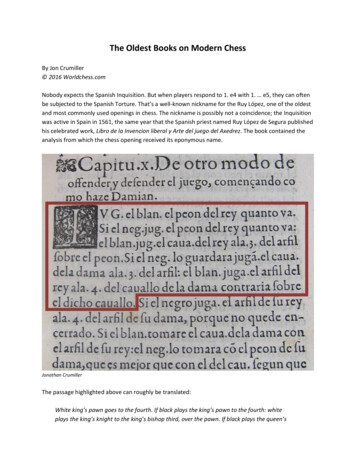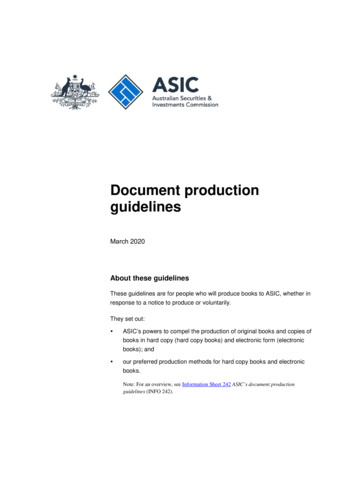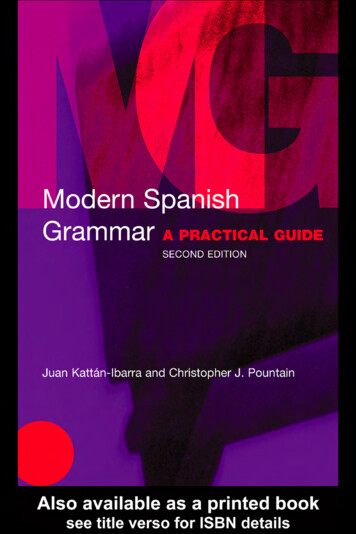
Transcription
The Oldest Books on Modern ChessBy Jon Crumiller 2016 Worldchess.comNobody expects the Spanish Inquisition. But when players respond to 1. e4 with 1. e5, they can oftenbe subjected to the Spanish Torture. That’s a well-known nickname for the Ruy López, one of the oldestand most commonly used openings in chess. The nickname is possibly not a coincidence; the Inquisitionwas active in Spain in 1561, the same year that the Spanish priest named Ruy López de Segura publishedhis celebrated work, Libro de la Invencion liberal y Arte del juego del Axedrez. The book contained theanalysis from which the chess opening received its eponymous name.Jonathan CrumillerThe passage highlighted above can roughly be translated:White king’s pawn goes to the fourth. If black plays the king’s pawn to the fourth: whiteplays the king’s knight to the king’s bishop third, over the pawn. If black plays the queen’s
knight to queen’s bishop third: white plays the king’s bishop to the fourth square of thecontrary queen’s knight, opposed to that knight.Or in our modern chess language: 1. e4, e5 2. Nf3, Nc6 3. Bb5.Jonathan CrumillerOn the right is how the Ruy López opening would have looked four centuries ago with a standard chessset and board in Spain. This Spanish chess set is one of my oldest complete sets (along with acompanion wooden set of the same era).
Jonathan CrumillerHere is the Ruy López as seen with that companion set displayed on a Spanish chessboard, also from the1600’s.Jonathan Crumiller
In addition to its contribution to opening theory, Ruy López’s book is historically important for codifyingsome of the game’s rules. For example, the book introduced the fifty-move rule that can determinewhen a game is drawn.Ruy López also states that the White pieces make the first move. Oddly, this rule did not becomestandardized until hundreds of years later. Howard Staunton, throughout his tenure as chess columnistfor the Illustrated London News (1844/5-1874), took a different stance, such as this column fromOctober 15, 1853:Illustrated London News, 1853-10-15It appears that the rule that White moves first was not fully accepted until the early twentieth century.One might assume that a Spanish priest would advocate a strict code of ethics and sportsmanship whileplaying the game. But here is a sample of the sage advice found in Ruy López’s book:Jonathan Crumiller“ when playing if it is a clear day, and sunny, is to have your opponent facing the sun,because it will blind him; and if it were dark and playing by the light of fire, move with
your right hand; because it disturbs the view, and the right hand will cast a shadow on thechessboard; so he will not be able to see where to play his pieces.”The Ruy López book in my collection was formerly owned by J.W. Rimington Wilson (1822-1877), afamous book collector and dealer in London in the mid-19th century. Rimington Wilson personallysigned many of the books in his collection. In general I am not a proponent of affixing signatures orbookplates to the antiquarian books in one’s collection, but Rimington Wilson’s signature from 150years ago makes it possible to know something about the book’s provenance, (though he signed it whenthe book was already 300 years old!). After Rimington Wilson’s death, the book was in the inventory ofBernard Quaritch, of whom The Times wrote, upon his death in 1899, “It would scarcely be rash to saythat Quaritch was the greatest bookseller who ever lived.”Ruy Lopez is towards the end of the transition from Medieval chess to modern chess, as shown by thefollowing timeline, which includes the works of other great writers about the game.Jonathan CrumillerTo put this timeline into some context, unlike the readers of Lucena and Damiano, the readers of RuyLópez’s book had the benefit of knowing that the earth revolves around the sun, rather than vice versa!A few words about the timeline and other chess publications from prior centuries. Some verysophisticated books on the game of shatranj, or chess with the “old rules,” were written in medievaltimes, and even much earlier. A prime example is Libro de axedrez, dados e tablas (Book of Chess, Dice,and Tables) commissioned in 1283 by Alfonso X (also called Alfonso el Sabio, or Alfonso the Wise), theKing of Castille, Leon, and Galicia. Another ancient work, Bonus Socius, a collection of chess problems,was published circa 1250-1275. Older manuscripts, some dating back to pre-1000 A.D., includedanalysis of highly advanced shatranj (old chess) problems. There are also ancient chess books that usechess as an analogy, or poetic device, for social commentary. These publications include Cessolis (c.1275-1300), Gallensis (c. 1470), Caxton (1474), and Vida’s Scacchia Ludus poem (1527). All of these
publications are beyond the scope of this article, which focuses on the early chess manuals thatembraced the modern rules of chess.The timeline shows that there appears to have been a gap of nearly 50 years between Ruy López’s bookin 1561 and its predecessor, authored by Damiano and published in Rome in 1512. Ruy López hadsought to correct and improve upon Damiano’s analysis.Jonathan CrumillerRoughly translated, “Another mode of playing attack and defense in the game’s opening as played byDamiano.” Damiano’s book included analysis of various openings, i.e. (what are now known as)Philidor’s Defense, the Giuoco Piano, Petroff’s Defense, the Queen’s Gambit Accepted, and others. Theopening named after Ruy López was not in Damiano’s book.Damiano’s first-edition chess treatise of 1512 was the first manual published in Italy for our “modern”game. In David DeLucia’s outstanding two-volume book, In Memoriam, he describes the first-editionDamiano as “ the rarest of all the Damiano editions and one of the rarest books written on the game ofchess.” The first Damiano edition was followed by seven more editions, dating from 1518 to 1564.These subsequent editions help explain the large gap in the timeline between Damiano’s first editionand Ruy López’s book in 1561.My chess book collection includes Damiano’s fourth edition (the first undated edition), circa 1528. Thetitle page shows a woodcut of two chessplayers with a game in progress.
Jonathan Crumiller
Aside from the perspective that makes the chessboard look like a large table, the board has someinteresting similarities with a 15th-century Italian chess board-box in my collection, from the Embriachiworkshop.Jonathan CrumillerDamiano’s book has a total of 92 woodcut chess diagrams. Most of the diagrams are for chessproblems, such as the following “White to move and mate in two”:
Jonathan CrumillerThis problem is looked upon favorably by The Chess Player’s Chronicle, Vol. 5 (1844):Chess Players Chronicle, Vol. 5, 1844Damiano provides the solution, in both Italian and Spanish, as follows.For White to checkmate Black in two moves, not more or less, first White moves the pawnto A [c7] and if Black gives check with the rook, then White covers with the knight andgives mate. If Black plays the rook to C [e5], then White makes a queen and it is mate. IfBlack makes a queen, then White plays the knight to B [b3] and gives mate withdiscovered [check] of the rook.
This edition of Damiano’s book, as well as the third edition dated 1524, included the first published setof helpful instructions for playing blindfold chess, with the title, “Arte de giocare alla mente” (Art ofplaying in the mind).Jonathan CrumillerThe chessboard on this page is the one diagram in the entire Damiano book in which there is not a whitesquare in the lower right-hand corner. Damiano’s book was actually the first to publish the rule ofhaving the white square in that corner, so it is ironic that in a chapter about strengthening one’s mentalsight of the squares, the board is rotated 90 degrees and therefore not displayed correctly!
The vast majority of Damiano’s book was not original. He had copied most of the chess material from anearlier work by Luis Ramírez de Lucena, published in Salamanca Spain in 1497, entitled Repetición deAmores y Arte de Ajedrez con 101 Juegos de Partido (“Repetition of Love and the Art of Playing Chesswith 101 Games”). The mate-in-two chess problem given earlier was one of many that had been copieddirectly from Lucena. Howard Staunton describes some of Damiano’s cherry-picking plagiarism in hisIllustrated London News (ILN) column of Sept. 12, 1863.Illustrated London News, 1863-09-12Lucena’s book is the earliest chess manual that still exists. As mentioned in Staunton’s column, Lucenabridged the gap between old and new by combining material from both styles of play: the oldtraditional style (called ‘el viejo’ by Lucena) and the new rules (called ‘de la dama’) which had just takenhold. In the older style of play, queens were limited to moving precisely one square diagonally andbishops moved precisely two squares along a diagonal. The new rules were the ones that are usedtoday and made for a much more exciting game because of the enhanced power for attacking.The material in Lucena’s book overlaps heavily with the Göttingen manuscript, as well as a handwrittenvellum document known as the Paris Manuscript. This latter document is in David DeLucia’s world-classcollection. All three documents are from the late 15th century, and some experts assert that all threedocuments were authored by Lucena. The Paris Manuscript does prominently display a Lucenasignature, presumably by Lucena himself.
Copyright David DeLuciaVery few copies of the Lucena book still exist today, and I have not yet been able to acquire an originalcopy. In my collection is a limited-edition reprint, published in Barcelona in 1953.A famous rook-and-pawn ending, known as the Lucena position, was actually not from Lucena at all, butrather from a later book, Salvio’s Il Puttino (1634). Misattributions occur relatively frequently in earlychess history; as a further example, Lucena’s book does indeed analyze the opening now known as theRuy López.
Jonathan Crumiller
It can be roughly translated:If [White] first plays the king’s pawn to the fourth square, play the same; and if he playsking’s knight to the third square of the bishop, play the knight of your queen to the thirdsquare of the bishop; and if he plays the king’s bishop next to your knight, play your king’sknight to the second square of your king; and if he takes the knight, take it with yours; andif he plays the queen’s bishop’s pawn to the third square to better engage your game, playyour queen’s pawn to the fourth square, because then you have a better game than him.And also because you play with your bishops: the king’s bishop to the queen’s third squareand the queen’s bishop to the king’s third square.Or in our modern language, 1. e4, e5 2. Nf3, Nc6 3. Bb5, Nge7 4. Bxc6, Nxc6 5. c3, d5.And although 4. Bxc6 Nxc6 5. c3 would never be seen in a high-level game today, the response 5. d5 isthe first choice of today’s top chess engines!Lucena’s book (and the similar documents) may share an unfortunate attribute of Damiano’s book:much of its material may have been copied from an earlier source. Which leads us to the earliest-knownchess book with modern rules: Libre dels jochs partits dels schacs en nombre de 100, authored byFrancesc Vicent and published in Valencia (now an autonomous community in Spain) in 1495. The bookis believed to be the first chess manual with the “modern” moves for the queen and the bishop. Comingfull circle, the author was a Valencian who fled to Italy, due to persecution from the Spanish Inquisition!No copies of Vicent’s book are known to exist today. Howard Staunton alluded to its extreme rarity inhis ILN column of June 17, 1854.Illustrated London News, 1854-06-17A gloomier verdict can be found in The Chess Monthly Vol. 3 (Sept 1881 - Oct 1882) edited by Hoffer andZukertort:The Chess Monthly, Vol. 2 1881-1882
For interested readers, the links between Vicent’s book and the Lucena document(s) are fully exploredin Jose A. Garzona’s book, El Regreso de Francesch Vicent (The Return of Francesch Vicent), published in2005.At this point we can only hope that a copy of Vicent’s book will someday be found.Photos of Mr. Crumiller’s collection are posted at chessantique.com and https://tinyurl.com/h76xvw6.
the first choice of todays top chess engines! Lucenas book (and the similar documents) may share an unfortunate attribute of Damiano [s book: much of its material may have been copied from an earlier source. Which leads us to the earliest-known chess book with modern rules: Libre dels jochs partits dels schacs en nombre de 100, authored by











